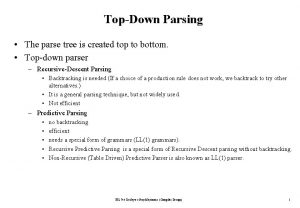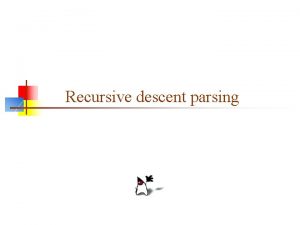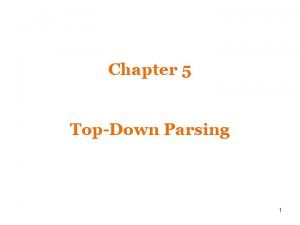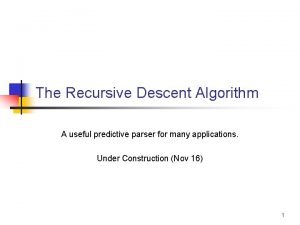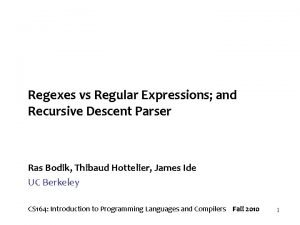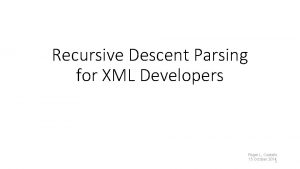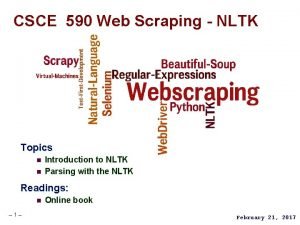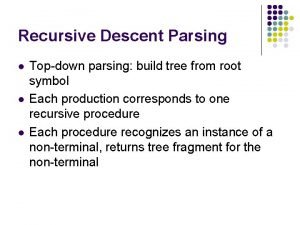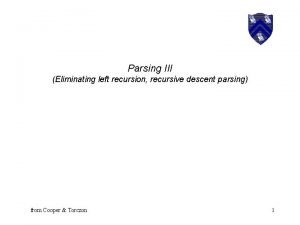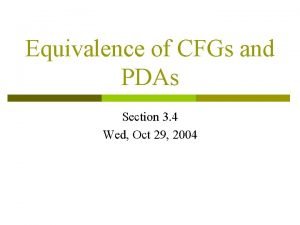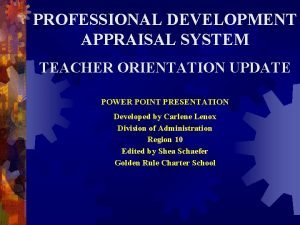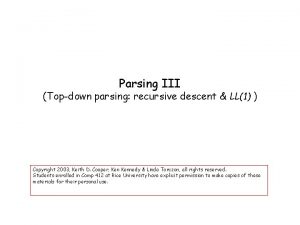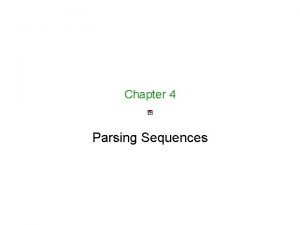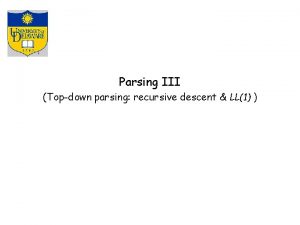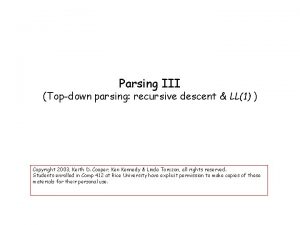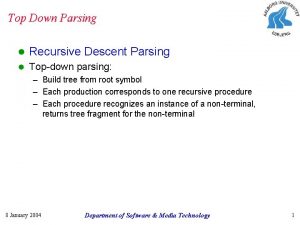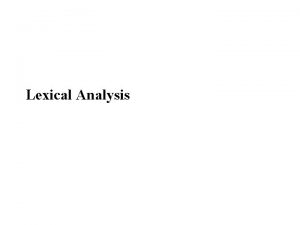Parsing XML Grammars PDAs Lexical Analysis Recursive Descent












- Slides: 12

Parsing XML Grammars, PDAs, Lexical Analysis, Recursive Descent

Recipe Book Markup Language • Why Markup languages? – Give structure of contents – aid in interpreting semantics of content, storing in database, etc. • Why XML? – Human readable (sort of) – Widely accepted and used for data interchange • Why RBML? – Don’t reinvent the wheel – use existing stuff IAAP – Simplest of the recipe XML formats I found

Formal Languages • What is a Formal Language? – Mathematically defined subset of strings over a finite alphabet • Regular Languages – Very simple, can be recognized by FSM – Still very powerful • Context-Free Languages – Pretty simple, can be recognized by PDA – Esp. useful for programming language

Regular Expressions/Languages • Alphabet, Σ = finite set of symbols • String, σ = sequence of 0 or more symbols in Σ* • Regular Expressions – The empty set, Ø – The empty string, ε is an RE and denotes {ε} – For all a in Σ, a is an RE and denotes {a} – If r and s are REs, denoting the languages R and S, resp. , then (r+s), (rs), and (r*) are REs that denote R U S, RS, and R*, resp.

Context-Free Languages • Context-Free Grammar G=<V, T, P, S> – V = variables – T = terminals (alphabet characters) – P = Productions – S = start symbol in V • Productions – Replace a variable with a string from (V U T)* – Example: E -> E + E | E * E | (E) | id

RBML Grammar cookbook -> “<cookbook>” title (section | recipe)+ “</cookbook>” title -> “<title>” pcdata “</title>” section -> “<section>” title recipe+ “</section>” recipe -> “<recipe>” title recipeinfo ingredientlist preparation serving notes “</recipe>”

RBML Grammar recipeinfo -> <recipeinfo> (author | blurb | effort | genre | preptime | source | yield)* </recipeinfo> ingredientlist -> <ingredientlist> ingredient)* </ingredientlist> preparation -> <preparation> (pcdata | equipment | step | hyperlink)* </preparation> serving -> <serving> (pcdata | hyperlink)* </serving> notes -> <notes> (pcdata | hyperlink)* </notes>

RBML Grammar equipment -> <equipment> (pcdata | hyperlink)* </equipment> step -> <step> (pcdata | equipment | hyperlink)* </step> ingredient -> <ingredient> (pcdata | quantity | unit | fooditem)* </ingredient> quantity -> <quantity> number | number "or" number | number "and" number </quantity> number -> integer | fraction | integer " " fraction -> integer "/" integer

Recipe Book Markup Language unit -> <unit> pcdata </unit> fooditem -> <fooditem> pcdata </fooditem> blurb -> <blurb> pcdata </blurb> effort -> <effort> pcdata </effort> genre -> <genre> pcdata </genre>

Recipe Book Markup Language preptime -> <preptime> pcdata </preptime> source -> <source> (pcdata | hyperlink)* </source> yield -> <yield> pcdata </yield> hyperlink -> pcdata url

Recursive Descent Parsing • Match required (literal) symbols • Call procedure to match variable – May itself call similar procedures

Lexical Analysis • Helps prepare for parsing • Uses regular language expressions to – Organize input into multi-symbol chunks – Each chunk has a meaning for parser
 Top down parsing
Top down parsing Recursive descent parsing
Recursive descent parsing How to make a recursive descent parser
How to make a recursive descent parser Non recursive predictive parsing
Non recursive predictive parsing Recursive descent parser calculator
Recursive descent parser calculator Recursive descent parser
Recursive descent parser Limitations of recursive descent parser
Limitations of recursive descent parser Nltk recursive descent parser
Nltk recursive descent parser Recursive descent parser
Recursive descent parser Eliminating left recursion
Eliminating left recursion Rob haitani
Rob haitani Pda to cfg
Pda to cfg Pdas domains
Pdas domains
